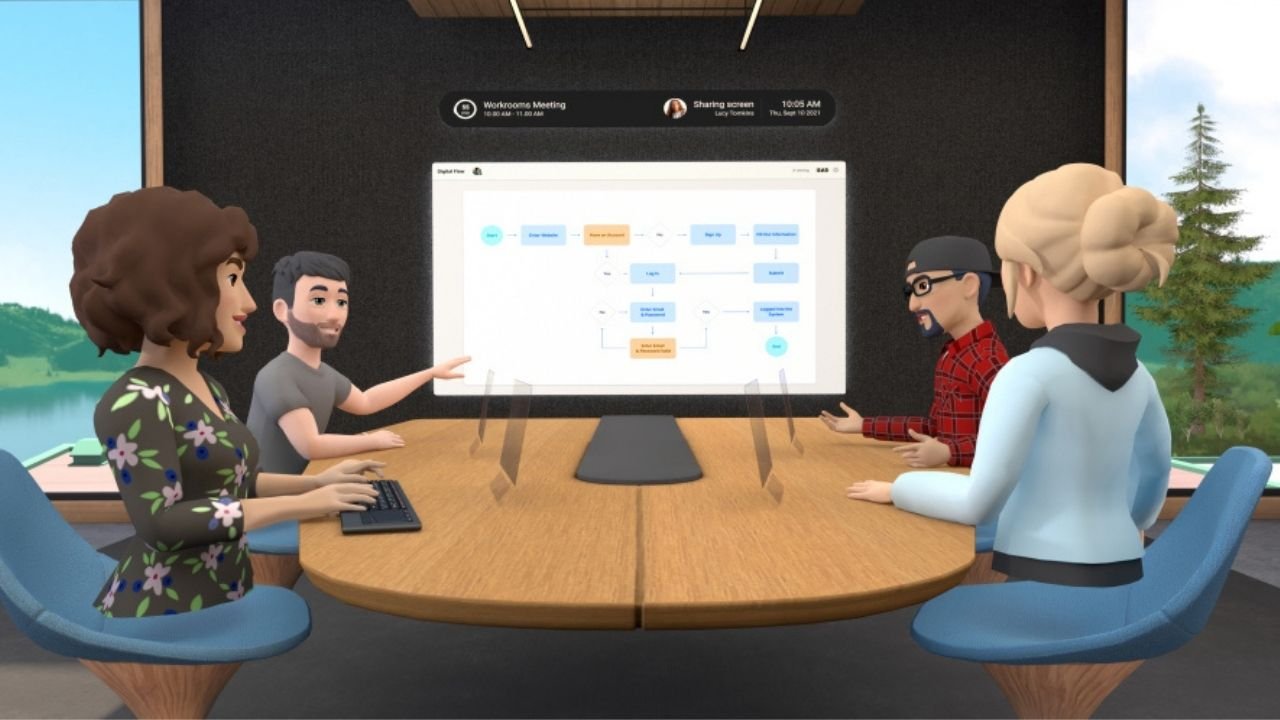- Some believe that the use of virtual reality (VR) and augmented reality (AR) will replace physical meetings or product presentations.
- Last week, Facebook announced Horizon Workrooms: Remote Collaboration Reimagined, a virtual meeting space.
- Employee experience, satisfaction, and mental health is crucial to a healthy workplace, and VR applications may improve these for workers in the very near future.
The technology that is used for remote work is advancing rapidly, and has been hugely spurred on by the pandemic and social distancing guidelines. Since 2013, Allwork.Space has predicted that virtual reality would become the future of the workplace.
The remote office lacks the fully immersive qualities of in person interactions; in the future, digital communication will likely include more senses besides sight and sound. It’s predicted that the use of virtual reality (VR) and augmented reality (AR) will replace physical meetings or product presentations, with the ability to interact as if coworkers were physically present. Without the right connective tools, remote work has its challenges.
VR and AR have the potential to boost the global economy by nearly $2 trillion in less than 10 years, so it’s not surprising that many companies are jumping on this new technology, which has the potential to provide companies with a competitive advantage in the workplace. VR can be used for training, work meetings, and to enhance the customer service experience.
Facebook tries its hand at VR
In 2020, Facebook released its VR headset brand Horizon, an Oculus for Business platform. Currently in beta, Facebook Horizon will allow its users to build and share collaborative online worlds in which they are able to socialize, play games, or work together on projects. This may assist workers in interacting digitally and more immersively in the remote and hybrid work models.
Last week, Facebook announced Horizon Workrooms: Remote Collaboration Reimagined. Workrooms is a virtual meeting space where coworkers can join a meeting in VR as an avatar or dial into the virtual room from a computer by video call. Workrooms will feature mixed-reality desk and keyboard tracking, hand tracking, remote desktop streaming, video conferencing integration, spatial audio, and the new Oculus Avatars, according to the news release from Facebook.
Workrooms was designed to allow people to use their hands and not controllers, which helps create a more natural and expressive social experience, as well as assist users in switching more easily between physical tools like the keyboard and controllers.
Up to 16 people in VR can be in a Workroom together, while an additional 34 people can join over a video call without wearing a headset. Workrooms is part of Facebook’s broader ambitions to build the “metaverse.” Facebook creator Mark Zuckerberg has said he wants Facebook to be primarily thought of as a metaverse company, or as Zuckerberg puts it, an “embodied internet.”
Facebook’s Workrooms is far from the only VR meeting app around
Anand Agarawala, co-founder and CEO of the immersive meeting app company Spatial, told The Information he sees Workrooms as focusing on a particular kind of meeting.
“It is a very faithful and literal representation of what it’s like to be in a Silicon Valley corporate campus. For better or worse,” Agarawala said.
Gabriel Baker, Head of Product at Virbela, makers of a VR coworking app called FRAME, echoed Agarawala’s view.
“Other companies are looking for these tools to actually extend beyond the things they might expect in a regular office,” Baker said.
How will VR impact the future of work?
Flex space and coworking industry:
- Flex workspace are designed to be used in conjunction with flexible working arrangements to provide workers with the freedom to work where, when, and how they want.
- VR is already inherently designed to provide employees with a variety of different places and ways to work.
- The flexible workspace and coworking industry could benefit from a closed zone where members can roam around while wearing a VR headset, a projection area where they could see and interact with a virtual space or individual pods where they could enter the virtual world.
Remote work:
- Workers will be free from daily commutes, having to wear professional office attire, and will not have to be in a single office or cubicle.
- VR can be accessed from the home, and personalized avatars in VR will allow for people to wear what they want at home without being seen by other team members.
- VR will assist in increased productivity – working remotely can increase productivity up to 77%, with 30% of workers doing more work in less time, according to a survey.
Hybrid officing:
- The rigid structure of the pre-pandemic workplace offered little to no flexibility; employees are happier and more productive when allowed to work in different locations, such as the home (through VR), the office, or a third space.
- Employees do not need to work in the same location every day. For decades, the belief has persisted that working in the office eight hours a day, five days a week is the most optimal strategy for productivity and company culture, but the past year has shattered that idea.
- Research from Alliance Virtual Offices has found that 68% of workers prefer a hybrid work model.
Employee experience, satisfaction, and mental health is crucial to a healthy workplace, and VR applications may improve these for workers in the very near future.


 Dr. Gleb Tsipursky – The Office Whisperer
Dr. Gleb Tsipursky – The Office Whisperer Nirit Cohen – WorkFutures
Nirit Cohen – WorkFutures Angela Howard – Culture Expert
Angela Howard – Culture Expert Drew Jones – Design & Innovation
Drew Jones – Design & Innovation Jonathan Price – CRE & Flex Expert
Jonathan Price – CRE & Flex Expert











